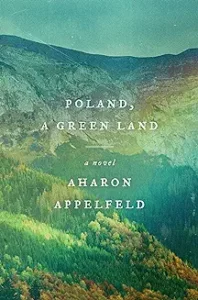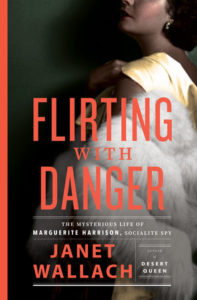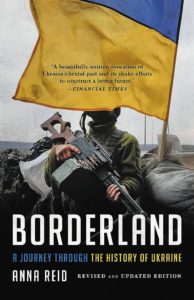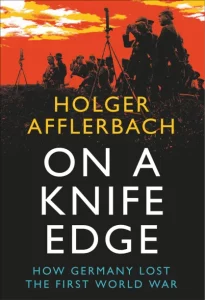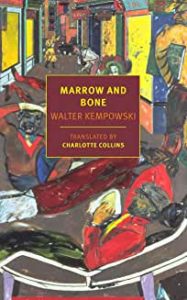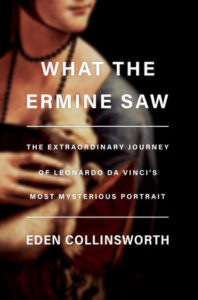Poland
A Vivid Spy Story
This is the biography of a wildly improbable life: born into wealth and privilege, Margaret Harrison changed careers from society news reporter to spy. That’s right, fluent in German, she was a spy for American military intelligence in post-WWI Germany. Harrison was tasked with taking the mood of the country from top to bottom. She did so, moving through a country filled with violence and practically dodging bullets in Berlin as various factions fought each other for control.
When she was assigned to discover what was really going on in Bolshevik Russia, Harrison learned Russian and sneaked into that country of vast convulsions, which was at war with Poland. She had no permission, but she had charm and wit and could think fast. Harrison was totally clear-headed about the risk of crossing over from Poland:
She was aware that once she reached the Russian side, she would have no one to turn to for help: no American diplomats had stayed in the country, no foreign embassies remained to represent her; she had no way to send a message out, and no one she knew to receive a message inside. She would be at the mercy of a dangerous adversary.
Hobnobbing with the literati and enjoying Moscow’s cultural richness amid the shortages of food and just about everything else didn’t last. She was forced to spy for the Cheka, the secret police–but that didn’t last, either. The book tips over into a sort of horror story when she’s arrested and imprisoned for well over a year in shocking, grotesque conditions that severely undermined her health–but didn’t diminish her spirit.
Multilingual, she was praised by spymasters for the best intelligence from Russia any agent was supplying, and as a media sensation, Harrison became a successful lecturer about Russian reality and her prison experiences. She left out being a double agent. Craving “hardships and adventures,” she went on to get more than her share as a reporter and occasional spy in Japan, Siberia, China, Korea, and Mongolia. Her energy is almost exhausting to contemplate, and the most astonishing episodes are worthy of an Indiana Jones reboot: a film she helped finance and starred in was set in an extremely remote part of Persia.
Flirting with Danger is filled with a blizzard of famous figures: politicians, artists, and writers from Winston Churchill to Emma Goldman and Maxim Gorky. The author is a supremely confidant storyteller, but she deserved a careful copyeditor who, for instance, was aware that German nouns are capitalized and knew that Germany was not “under authoritarian rule” in 1924. She also needed an editor who could have reined in the profusion of adjectives, many over-long sentences, excessive attention to meals, and florid phrases like this one: “her eyes danced like clouds in a blazing sky.”
It’s also disturbing that the author twice labels gays and lesbians in 1919 Berlin as “sinister” when this was a time of unprecedented freedom and openness for that community. The portrait of Berlin seems skewed, perhaps reflecting Harrison’s own apparent prudishness, and readers will find a much more nuanced assessment of the city right after WWI in Claire McKay’s Life and Death in Berlin.
All the same, Flirting with Danger is a memorable book about an unforgettable woman. ★★★
Lev Raphael has reviewed books for the Detroit Free Press, The Washington Post and other publications. Biography is one of his favorite genres and he recently reviewed The Art Thief.
Ukraine Then & Now
If you want to understand the conflict in Ukraine and go behind the headlines, there’s no better place to start than Anna Reid’s Borderland: A Journey Through the History of Ukraine. Deeply researched, elegantly written, totally enthralling, the book explores the history of Ukraine back to the Vikings and how Ukraine and Russia have followed completely different paths.
Unlike Russia, which became an autocratic empire, Ukraine has been ruled and misruled by Poland, Lithuania, Austria-Hungary and of course Russia. A key to the current slaughter of Ukrainians and the seizure of vast swathes of territory–as well as what sounds like crazy rhetoric on Russian talk shows–is a profound Russian delusion about this country that hasn’t been independent very long but has an undeniable historic existence, culture, and language. Reid notes that historically Russians have regarded
Ukrainians as really just a subspecies of Russian…Any differences that did demonstrably exist between them were the artificial work of perfidious, Popish Poles–replaced in today’s Russian imagination by the meddling West in general. Rather than attacking Ukrainians and Ukrainian-ness as inferior, therefore, Russians deny their existence. Ukrainians are a “non-historical nation,” the Ukrainian language a joke dialect, Ukraine itself an “Atlantis–a legend dreamed up by Kiev intellectuals”…The very closeness of Ukrainian and Russian culture, the very subtlety of the differences between them, is an irritation.
That was written in the 90s; now the irritation appears to have turned to seething hatred.
Blending history, personal exploration, and interviews, the book is unique because it is divided into two parts: the first was published in 1997 90s when a democratizing Russia under Yeltsin seemed highly unlikely to attack its neighbor. The second, of course, was written after Putin launched his “special military operation” at a time when Russia seems like a fascist state to many international analysts–and certainly to Ukrainians who have experienced fascism under the Nazis.
Reid doesn’t pull any punches exploring Ukrainian antisemitism and pogroms or the country’s lack of readiness to face up to the truth the way Germany has done about the Holocaust. Nor does she whitewash past governmental and cultural corruption. Reid is especially adroit at discussing how Ukrainian nationalism has been growing stronger and investigating the role of the Ukrainian language in a country where many people have been bilingual and Ukrainians have Russian relatives and marriages are often “mixed.”
If you’ve read Bloodlands by Timothy Snyder, Reid’s book is a perfect companion piece, vitally important work that has been superbly edited and updated. ★★★★★
Lev Raphael is the author of 27 books in genres from memoir to mystery and his work has appeared in over a dozen languages. He has reviewed books for The Detroit Free Press, The Washington Post and a handful of public radio stations.
WWI “On A Knife Edge”
How did the Germans lose WWI when at times, according to this new history, they came close to winning early on? The reasons are varied and fascinating in a beautifully detailed, in-depth exploration of German motives, perceptions, actions, and failures of imagination.
One determining factor was that Germany’s high command was riven by strategic and personal disputes and these also existed across the various “power centers” in Kaiser Wilhelm II’s empire at the time including the Kaiser and his court, the German parliament, the army’s Supreme Command and the army itself. Some generals wouldn’t even speak to each other for weeks at a time. And conditions only got worse over time with miscommunications and fiction between generals and politicians, politicians and the high Command, with the Kaiser growing more and more delusional.
Just as significant, Germany’s new intelligence service was severely understaffed and thus prone to making wildly incorrect judgments, as for instance ranking the U.S. a less significant military power than Bulgaria. Or positing that England could be handily quarantined by only a handful of U-boats. Far more devastating, in The Battle of Verdun, the Germans grossly overestimated French losses and never planned for heavy German losses.
German prejudice about the French was widespread among the powerful decision makers. The French were under-rated in terms of their military performance, and perhaps just as seriously, as a people. One high echelon leader thought that “the French national character showed a tendency towards hysterical mood swings.” That’s funny and tragic at the same time.
Another military leader believed that Germany would always beat France no matter what, since “the character of our dear neighbours has hardly changed since 1870.” Such dismissive and contemptuous views were widespread in Germany as a whole and certainly among the military’s elite, despite French superiority of numbers in many sectors of the Western Front and Germany’s continued inability to strike a knockout blow on their opponents. As if such arrogance wasn’t enough to tip the scales against Germany, political and military leaders could not agree on war aims, what would be an acceptable peace agreement, and whether to annex conquered territory or not. The politicians too often “chose the stupidest possible course of action” and overall throughout the war, “Germany’s approach was largely incoherent and chaotic.”
Though tragedy abounds, sometimes the events slip into farce. One example: Germany and Austria-Hungary had divided Russian Poland between them and wanted to mobilize a Polish army to fight against Russia. They proclaimed a new Kingdom of Poland without there being a king, government, constitution, parliament or anything else you’d expect for a new nation. The plan was a dud.
While the book is somewhat slow to get going, once the author delves deeper into the often chaotic decision-making process for Germany and its allies, this study becomes truly compelling. I’ve read many books about WWI, but because this one focuses less on the battles and more on everything happening behind the scenes, the progress of the war seems much clearer. It’s a refreshing narrative and the memoirs, diaries, and letters of key figures that he quotes give the book startling immediacy. ★★★★
Lev Raphael has reviewed for The Washington Post, The Detroit Free Press and other publications as well as three public radio stations in Michigan. He recently reviewed the classic WWI novel All Quiet on the Western Front.
Marrow and Bone
Jonathan Fabrizius is a journalist living comfortably in 1980s Hamburg thanks to a rich uncle, but his thoughts often turn to the Nazi years and the end of WWII when his family fled East Prussia. His mother died in a cart giving birth to him and that death and the chaos of flight sometimes seem more real than the life he’s living.
Out of the blue, he gets an assignment to travel in a luxurious new Japanese car into former East Prussia to report on local culture while the driver and another passenger record the route for a future rally. And the fee is tremendous: 5,000 marks with negotiable expenses.
As he thinks of it, “his job was to write an article about the cultural riches of the People’s Republic of Poland.” Given that he’s traveling through a once-German region that was called Masuria, despite new Polish names for towns, those riches don’t seem very Polish or even much in evidence. He’s most impressed by a massive medieval fort built by the Teutonic Knights and a huge Gothic redbrick church. Such churches in northern Europe are his obsession.
The tone of dark and sometimes bizarre humor is set almost immediately by the work his Swedish girlfriend is doing to curate a museum exhibition on cruelty. She’s gathering materials about massacres and torture with a museum director who actually believes that excessive “pedantry” can be a form of “secondary” cruelty–and so can hit-and-run accidents.
There are no accidents on Jonathan’s off-kilter road trip, but it’s broken up by an unexpected robbery, encounters with curious peasants and obnoxious German tourists, meals that are inconsistent or not available, shabby hotels, and Jonathan’s travel companions. They work for the car company: Hansi is a famous race car driver with epic adventure stories behind him and chatty Frau Winkelvoss wears twenty-six necklaces, harem pants and a blizzard of scarves as she and Hansi help record the route in meticulous detail. Their “map” will guide drivers in some future rally.
Jonathan’s snark is his shield against feeling anything much at all. A typical observation: When Frau Winkelvoss can’t get good coffee at a Polish café he notes “Presumably during the war there wouldn’t have been any coffee here under the Germans either.”
The trip into his past (and Germany’s) challenges and then slowly strips away his sarcasm as he comes closer and closer to where his parents died and to an infamous concentration camp–that he can’t get into.
In Europe Kempowski is considered one of Germany’s greatest postwar writers but I hadn’t heard of him until I was on a book tour for the memoir My Germany and a professor said I had to read his book Have You Ever Seen Hitler? It’s based on interviews with people who lived through the rise and ruin of Nazi Germany and had wildly different opinions of their Fuehrer. The book is a stunning record of a country where many people worshiped Hitler like a god,.
Equally stunning is the richly layered and detailed novel All for Nothing, set in an East Prussian manor house whose inhabitants see waves of refugees fleeing the Russian troops. That book and this one have particular bite because Kempowski apparently himself witnessed waves of refugees as a teenager near the end of WWII.
Marrow and Bone is a sobering meditation on memory, forgetting, and the price paid for both.
Lev Raphael is the author of The German Money and twenty-six other books in many genres.
A Mighty Masterpiece on the Move
If every picture tells a story, then a masterpiece, one by Leonardo Da Vinci, must be full of stories that make for an epic, and Eden Collinsworth serves them up in grand style in her thrilling new book What the Ermine Saw.
The painting is the seductive, engrossing, and enigmatic portrait of Cecilia Gallerani, a Renaissance Duke’s mistress, holding, of all things, an ermine. It’s the strangest lapdog you’ve ever seen and has sometimes actually been misidentified over the years as just that, a dog. An ugly dog, too. But there’s nothing ugly about the painter’s execution, his delicacy, his tones that seem as fresh and magical as when they were painted over 500 years ago.
What is she looking at? And why is she holding an ermine? The author deftly explores both mysteries.
The painting in modern times has traveled from its base in a Polish museum around the world on loan and been transported with almost unimaginable security given its worth and rarity, one of only fifteen of Leonard’s paintings to survive. Reading about the security around its movements, you feel like you’re in the middle of an amazing heist movie–though luckily the painting survived intact wherever it went.
How it got to Poland is somewhat mysterious as there’s a gap of almost 250 years in its history, but what’s more mysterious than that is its having survived wars, revolutions and every kind of disaster you can imagine–with only some minor damage to an upper corner.
Along the way and crossing one border after another in Europe, we get stories of love, lust, greed, cruelty, family feuds–plus Nazi madness and obsession. There are capsule portraits of individuals you’re unlikely to have heard about, some of them heroines like Rosa Valland at the Louvre, who kept track of the vast stores of art the Nazis looted from Jews in France. Her secret records aided restitution to the original owners and museums after WWII.
The book is a fast, stunning read as we whirl from one century and country to the next, from palaces to hovels, and all the while the small painting shines at the center, a jewel of jewels, a magnet for the very best of humanity and also the very worst.
Collinsworth has written a book that will delight art and history buffs and yes, even fans of Dan Brown’s The Da Vinci Code. Because hovering over everything is the spirit of one of the world’s greatest artistic geniuses, a man whose legacy has affected and inspired countless millions. To turn these pages is to feel connected to his genius, however tangentially, to be graced and possibly even changed.
Lev Raphael has been an art lover since he was very young and has visited dozens of art museums across the U.S., Canada, and Europe. The author of 27 books, he taught creative writing at Michigan State University and currently coaches, mentors, and edits writers in all genres at writewithoutborders.com.
Travels Through Europe’s Heart of Darkness
I was born in New York City to immigrant parents, and when I was young, the question “Where do your parents come from?” wasn’t an easy one to answer.
My father had grown up in the easternmost part of Czechoslovakia which had different names over the course of his youth: Subcarpathian Ruthenia, Carpathian Ruthenia, and the Carpatho-Ukraine. But it didn’t belong there anymore. It had been absorbed by the Ukraine and was now part of the USSR.
Some people didn’t even seem to know where Czechoslovakia was, anyway. Now of course, it’s not on the map at all, having split into the Czech Republic and Slovakia.
The city my mother grew up in northeastern Poland was Wilno, but as Vilnius, it was the capital of the Lithuanian Soviet Socialist Republic. In her years there as a child and a young woman before the Holocaust, it had been variously part of Russia, Poland, Lithuania–but for the majority of those interwar years a Polish city. It had also twice been invaded and ruled by the Germans.
Both my parents spoke a bewildering array of languages and lived in borderlands, as Pulitzer-winning author Anne Applebaum calls them in her dazzling travelogue Between East and West.
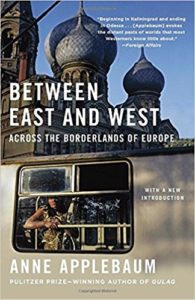 Armed with fluent Polish and Russian, the author records amazing interviews and fascinating, lost history as she travels from the Baltic to the Black Sea, visiting almost two dozen cities like Odessa and Minsk whose names are well known in the West. But she mainly stops at smaller cities and towns who have been pinballed over the centuries, swept up in endless wars, invasions, and border changes. En route, she also traverses some areas of Eastern Europe likely unknown to most Americas, each with its own dramatic, many-layered history: Ruthenia, Bukovyna, Moldova.
Armed with fluent Polish and Russian, the author records amazing interviews and fascinating, lost history as she travels from the Baltic to the Black Sea, visiting almost two dozen cities like Odessa and Minsk whose names are well known in the West. But she mainly stops at smaller cities and towns who have been pinballed over the centuries, swept up in endless wars, invasions, and border changes. En route, she also traverses some areas of Eastern Europe likely unknown to most Americas, each with its own dramatic, many-layered history: Ruthenia, Bukovyna, Moldova.
Some cities have been crushed by neglect, Sovietization, bombing—or all three. Others seem like lost jewels. Everywhere she goes, people from peasants to professors open up to her to reveal contradictory identifications. Russian speakers across these lands, for example, might think of themselves as Ruthenian, Polish, or Ukrainian. The locales she travels through have known immense suffering and chaos, and many of her interviewees come across as shipwrecked. Best of all, her grasp of complicated history in every location is faultless. She’s as observant, canny, and in command of le mot juste and just the right quote or anecdote s Rebecca West was in her masterpiece about the Balkans, Black Lamb and Grey Falcon.
Here she is in discussion with a fascinating Ukrainian linguist with a Turkish surname who tells her he feels like an outsider in his own country:
“And that, he said, was the most Ukrainian thing of all: to read the history of your country as if you were reading it through an outsider’s eyes. It is the fate or borderland nations always to know yourself through the stories or other, to realize yourself only with the help of others.”
Between East and West is one of the most compelling and thought-provoking travelogues I’ve read in years—and vitally important cultural/historical background now that places like Crimea and the eastern Ukraine keep blasting into the news.
Lev Raphael is the author of Rosedale in Love, A Novel of the Gilded Age, and 24 other books in genres from memoir to mystery.

